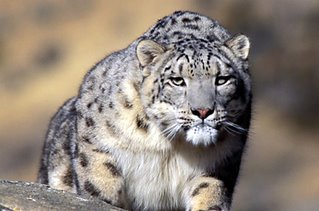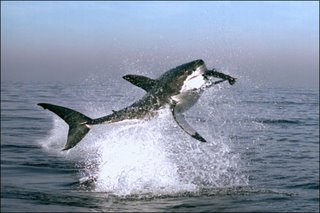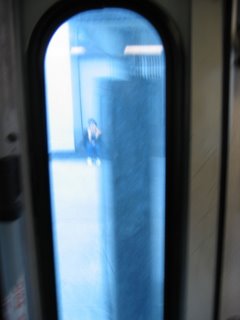When you watch BBC-produced "Planet Earth" - an 11-part wildlife series making its US premiere March 25 on Discovery - you probably become very angry at the increasing use of CGI in nature documentaries.
Should someone somehow convince you that, in fact, no CGI was used in "Planet Earth", it's still going to be hard to swallow the absurd assertion that the series was shot in HD.

In the studio, the transition from film to video has been relatively smooth. Monitored soundstage conditions have helped HD along in its progress toward become the standard motion picture recording medium. But the wild unpredictable world of documentary filmmaking, where the authenticity and transparency of the image are of paramount importance gives HD technology the chance to really show its colors – or its flaws.
"Planet Earth" is another product of what must be one of the consistently great filmmaking entities of the last 30 years – the BBC documentary department, often in collaboration with
Sir David Attenborough. From the beginning of Attenborough's tenure at the BBC in the 1970's, the BBC pushed the envelope of what the nature documentary could be. He demanded the best technology and technicians, providing the best footage and the best science available. In a sense, every documentary series the BBC has produced has been an attempt to outdo the last one.
Alastair Fothergill, executive producer of "Planet Earth", had been producing groundbreaking wildlife series with Attenborough since "The Trials of Life" in 1990. It was Fothergill who brought nature documentaries fully into the 21st century, by deciding to invest in equipment and techniques normally out of the budget range of nature films.
As a result, "Planet Earth" features extraordinary images of a type and quality previously only visible in the realm of big-budget commercials and features.

The workhorse camera of the series was the
Panasonic VariCam HD, chosen because of its distinctly clean image and variable frame rate. The Sony HD Cam was also used in several instances. In a couple instances, where the loss of an HD camera would prove too great a risk for the continuation of the shoot - in the remote jungles of Guyana, for instance, and also a year-long Antarctic shoot – 35mm and Super 16mm cameras were used, because they were known quantities and parts could be easily replaced in the event of a breakdown. However the Panasonic VariCam endured enough environmental adversity in deserts, mountains, caves, oceans, and forests to prove itself to be admirably rugged and reliable.
Another advantage of shooting in HD was the simple, but priceless, ability to look at footage on a daily basis. Nature documentaries, relying heavily on shooting film, are also in the precarious position of never being certain of the footage quality until it returns from the lab. A great deal of time, money, and effort might be spent capturing a natural phenomenon likely to last only a couple days, only to discover a week later that it was all for naught. Looking at real "dailies" also aided in planning the next day's shoot.
The dilation and compression of time is a tour-de-force element of "Planet Earth". The series used, for the first time on a major wildlife program, digital cameras for time-lapse sequences. Digital still cameras captured images which were turned into QuickTime movies, and these were then rendered out to high definition images. The same benefit conferred by shooting real time HD footage was enjoyed in the time-lapse sequences. Progress on the time-lapse could easily be checked on a laptop, again reducing the chance of potential surprises when the footage was finally replayed at speed. Producer
Huw Cordey, veteran of David Attenborough's
"The Life of Mammals" series, shot jungle, desert and cave sequences on "Planet Earth" and used digital time-lapse extensively: "One of the biggest problems with doing a time-lapse, because you're not actually watching it in the time-scale that you're filming it, is you can't tell if it's any good or not until you've seen it. Shooting film, so many of these time-lapses would be N.G. The ability to look at it saves you a lot of time, and in the end you get better sequences and better shots."

Super 16 Arri SR2 cameras were used for high-speed shooting up to 150 fps, but "Planet Earth's" staggering super-slow motion scenes – including shots of the unique and terrifying great white attacks on seals off the coast of South Africa – used digital technology. These slow motion scenes were shot at up to 400 fps using a
Photron camera. Photron has made cameras for a variety of high speed purposes, including industrial crash-testing, since the 1970's. The Photron camera used on "Planet Earth" is continuously running, recording to a hard drive, always maintaining a 2.5 second cache, so when the camera was activated, two-and-a-half seconds of footage previous to the "start" point has already been recorded. This allowed capture of the entirety of sudden and unpredictable moments which would have been a monumental challenge to shoot on film. "Planet Earth" was the first production to use the Photron system in the field, let alone out on the open ocean shooting great whites, or the deep jungle shooting flying frogs.
Another "Planet Earth" highlight is the series' stunning aerial footage, which employed the
Cineflex camera stabilization system. Helicopter shots can defeat their own purpose on wildlife shoots, because the noise and motion of the helicopter frighten any wildlife the helicopter approaches. The Cineflex allowed the helicopter to shoot from a long way off with animals unaware they were being observed. The Cineflex has been used widely on feature films, commercials, and news. This is the first time it has been used in a documentary. Operated by via joystick, the system consists of a gyro stabilized camera system that sits in a 14.5 inch diameter ball turret in the nose of a helicopter. It is comprised of five rotating axes, three of which are gyro-stabilized. Its stability allows use of very long lenses which be impossible to keep stable in a standard mount. A 40x zoom lens was used for "Planet Earth".
The shooting of HD using the Cineflex brought other benefits too. Compared to bulky 35mm film camera systems, the Cineflex is fairly lightweight at about 85 lbs. In helicopter flight, even a slight weight difference can affect fuel consumption. The savings in weight allowed the aerial crew to stay up in longer, sometimes forthree hours at a time, changing tapes as necessary. A film camera system might necessitate landing after only 11 1/2 minutes - and that’s shooting a thousand foot magazine. As is often case, the simplest solutions prove the most valuable. The convenience factor of HD - not having to land to change film and the lighter system and the savings on time and fuel with the lighter system and not having to land to change film proved invaluable to the crew in terms of time, money, and ability to capture footage.
In addition to springing for technology, Fothergill went for the best crew.
Michael Kelem has been the aerial D.P. on dozens of feature films including "Mission: Impossible" and "Black Hawk Down" as well as countless commercials. With over 40 years in the industry, "Planet Earth" was the first documentary he ever shot – as well as being the first production on which he had to please eight different director/producers.
The aerial photography crews consisted of three people: the segment director/producer, a helicopter pilot who was sourced at each location, and Michael Kelem. Working on a documentary brought its own set of creative challenges and also great rewards:
"For me, the shot reveals itself as I'm working. The idea comes to me in the moment and I have to be able to communicate that to the pilot on the spur of the moment and hope that he is able to see what I’m seeing and act upon it because you may only have one chance at it … We might use the topography to create a reveal or use something like a tree to give some foreground motion. Or with a really long zoom lens you can have the background spin wildly as you circle around a central point of focus. In essence, you create the shot as you see the action unfolding in front of you given the circumstances which you've just discovered. It's a challenging way to work but it teaches you to go with your instincts and to be open to all possibilities."
The series episodes, as presented by the Discovery Channel in the US, are slightly shorter than those that originally aired in the U.K. The original voiceover narration by Sir David Attenborough has been replaced in the US release with a voiceover by Oscar-nominated actress, Sigourney Weaver.
(end)
Labels: media production, nature documentaries
 In the studio, the transition from film to video has been relatively smooth. Monitored soundstage conditions have helped HD along in its progress toward become the standard motion picture recording medium. But the wild unpredictable world of documentary filmmaking, where the authenticity and transparency of the image are of paramount importance gives HD technology the chance to really show its colors – or its flaws.
In the studio, the transition from film to video has been relatively smooth. Monitored soundstage conditions have helped HD along in its progress toward become the standard motion picture recording medium. But the wild unpredictable world of documentary filmmaking, where the authenticity and transparency of the image are of paramount importance gives HD technology the chance to really show its colors – or its flaws. The workhorse camera of the series was the Panasonic VariCam HD, chosen because of its distinctly clean image and variable frame rate. The Sony HD Cam was also used in several instances. In a couple instances, where the loss of an HD camera would prove too great a risk for the continuation of the shoot - in the remote jungles of Guyana, for instance, and also a year-long Antarctic shoot – 35mm and Super 16mm cameras were used, because they were known quantities and parts could be easily replaced in the event of a breakdown. However the Panasonic VariCam endured enough environmental adversity in deserts, mountains, caves, oceans, and forests to prove itself to be admirably rugged and reliable.
The workhorse camera of the series was the Panasonic VariCam HD, chosen because of its distinctly clean image and variable frame rate. The Sony HD Cam was also used in several instances. In a couple instances, where the loss of an HD camera would prove too great a risk for the continuation of the shoot - in the remote jungles of Guyana, for instance, and also a year-long Antarctic shoot – 35mm and Super 16mm cameras were used, because they were known quantities and parts could be easily replaced in the event of a breakdown. However the Panasonic VariCam endured enough environmental adversity in deserts, mountains, caves, oceans, and forests to prove itself to be admirably rugged and reliable. Super 16 Arri SR2 cameras were used for high-speed shooting up to 150 fps, but "Planet Earth's" staggering super-slow motion scenes – including shots of the unique and terrifying great white attacks on seals off the coast of South Africa – used digital technology. These slow motion scenes were shot at up to 400 fps using a Photron camera. Photron has made cameras for a variety of high speed purposes, including industrial crash-testing, since the 1970's. The Photron camera used on "Planet Earth" is continuously running, recording to a hard drive, always maintaining a 2.5 second cache, so when the camera was activated, two-and-a-half seconds of footage previous to the "start" point has already been recorded. This allowed capture of the entirety of sudden and unpredictable moments which would have been a monumental challenge to shoot on film. "Planet Earth" was the first production to use the Photron system in the field, let alone out on the open ocean shooting great whites, or the deep jungle shooting flying frogs.
Super 16 Arri SR2 cameras were used for high-speed shooting up to 150 fps, but "Planet Earth's" staggering super-slow motion scenes – including shots of the unique and terrifying great white attacks on seals off the coast of South Africa – used digital technology. These slow motion scenes were shot at up to 400 fps using a Photron camera. Photron has made cameras for a variety of high speed purposes, including industrial crash-testing, since the 1970's. The Photron camera used on "Planet Earth" is continuously running, recording to a hard drive, always maintaining a 2.5 second cache, so when the camera was activated, two-and-a-half seconds of footage previous to the "start" point has already been recorded. This allowed capture of the entirety of sudden and unpredictable moments which would have been a monumental challenge to shoot on film. "Planet Earth" was the first production to use the Photron system in the field, let alone out on the open ocean shooting great whites, or the deep jungle shooting flying frogs.



 And watch the Ralph Bakshi animated movie, "The Lord Of The Rings" (1978) which covers "The Fellowship Of The Ring" and some of "The Two Towers".
And watch the Ralph Bakshi animated movie, "The Lord Of The Rings" (1978) which covers "The Fellowship Of The Ring" and some of "The Two Towers".